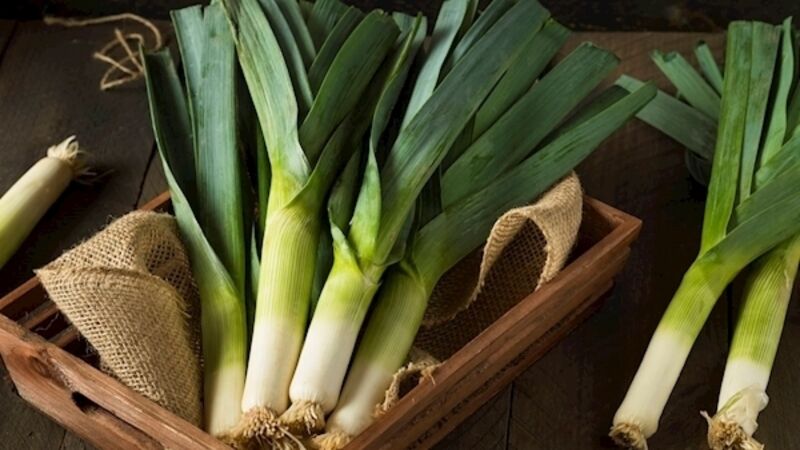Fixing leeks in the cold snap

Chilly weather can sweeten or mellow some winter vegetables, writes
Winter has been mild enough this year but we’ve already felt a chill over the past few days. Heavy frosts will soon bitter the gardening experience yet sweeten the edible gardeners parsnips and other root crops, including overwintering onions and garlic by causing the starches in their fibres to produce more glucose molecules. Every cloud… as some say.
Leeks are in the onion family but are the only one not to form a bulb yet they will also acquire a frost-touched taste change; moving from the sharp oniony of pre-Christmas harvests to a more mellow flavour from now until the last of the yield is cooked.
This is part of the tradition of overwintering them, you get flavour variety but it is also because leeks do not store well, or at least not for long once lifted, so leaving them in the ground until needed is the best way to get the full bounty of the vegetable. Some years that’s a risky game of weather roulette; earlier this week I was easily able prize up a cache with just a rock of the garden fork but other years (harsher years) you’d be needing to join the Fenian brotherhood to dynamite them out of the ground.
That may yet be the incendiary case in late Feb or early March, and then back to a gentle lever after Patrick’s weekend or an extensive cold spring may just terminally damage the cellular structure and one might just rue not lifting before St Brigit’s.
We used to codify these things by phases of the moon or the proximity of a solstice or equinox or the feast days of faiths closest to those vernal markers but climate change means old reliances are fast becoming mis-markers.
If you spy a weather pattern on the way that might just harden your ground to rock solid then you will want to prise up a few to keep you going, if not the majority. Once upon a time, a root cellar or sand box in a cool shed would keep lifted leeks viable for up to 2-3 months. Our loss of such practices and our modern warm homes means even the cooler press or the vegetable drawer will dry out the veg in a fortnight.
One tip of extending storage is to not trim them down as you see them displayed on the supermarket shelves — that only shortens their storage to a few days at best. Instead keep the roots on, this will give a good week or more to their crunch and juiciness. If you preference storing in the fridge then you can clean up and trim but do use as quick as you can as they will begin to loose flavour and health benefits within days. That said, wrapping them in a damp paper towel inside the refrigerator gives some stretch and may get you a week to 10 days.
While hardy as hell under snow, Leeks don’t freeze well and almost defrost straight to mush — problematic for stir fry or pie yet redeemably grand for soup. When it comes to cooking, one tip I learned while kitchen portering my way through college is to slice leeks lengthways down the middle — this makes it easier to rinse out any soil or grit that may have gotten between the foliage layers.
Many gardeners put collars on leeks to prevent such contamination — a loo roll or a cardboard construction with string and cane support. It is also a way to achieve really white and straight stems. It is a form of blanching (keeping photosynthesis off a stem section) and of forcing a straight-up surge of growth toward the light. The white stem or stalk is considered the edible part of the leek but the greenery is also delicious and nutritious- so if you haven’t collared and tamed not all is lost to a wild abandon.
Speaking of wild abandon — some etymologists like to link the word ‘leek’ to an old roman denotation of a ‘lickable medicine’ — some thing to cure sore throat. On one hand I’ll stick with the honey and lemon lozenges but there is some credibility in leeks as a valid sore throat remedy. So leeks just like garlic are rich in phytochemicals which are known to enhance general immune function and in particularly are stuffed with sulforaphanes which activate T-cells to better track down and destroy invaders — be that the viral or bacterial agents of that raspy or razor blade throat.
Don’t worry, you won’t have to lick, you can get those compounds into your bloodstream by way of a pleasant soup. I am a fan of no fuss simple pleasures and leek soup is one of my favourites. Simply, a cup and a half of water, a ½ cup of cream, a cup of washed and chopped leeks, 2 precooked potatoes, a knob of butter and a pinch each of black pepper and sea salt. Sauté half the leeks, add in the water and rest of leeks, bring to boil, simmer 5mins, peel, dice and add potatoes and simmer another five, hand blend to consistence of choice, add the cream and heat through, salt and pepper to taste. Well, you can lick the spoon.
Leeks have a medicinal botany track record that includes support to diabetes, atherosclerosis, cardiovascular disease and stroke risk via their ability to protect the lining of blood vessels, to reduce inflammation and to help the metabolism of glucose.
Leeks are a source of vitamin K which assists wound-healing mechanism and supports connective tissues. Leeks have tradition in alleviating anaemia and they are rich in both iron and manganese which are required for the formation of haemoglobin. Packed with antioxidants and also vitamin C, they exert a general wellbeing effect, nutritionally.
So, apart from harvesting leeks this month, we can be on the lookout for some seed packets as it is possible to start leek seeds as early as mid Feb. Leeks will be ready to harvest and use generally within 90-100 days of sowing — so you can stagger sow through the year.













